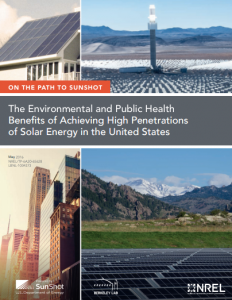Full Title: The Environmental and Public Health Benefits of Achieving High Penetrations of Solar Energy in the United States
Author(s): National Renewable Energy Laboratories
Publisher(s): National Renewable Energy Laboratories
Publication Date: May 1, 2016
Full Text: Download Resource
Description (excerpt):
The U.S. Department of Energy’s SunShot Initiative (SunShot) seeks to motivate swift reductions in the cost of solar energy in order to strengthen the role of solar as a low-cost energy source. The SunShot Vision Study (DOE 2012) evaluated the profound implications of such cost reductions for the solar industry, the electricity sector as a whole, and end-use electricity consumers, finding that achieving the SunShot cost targets could result in overall solar electricity penetrations of 14% of annual U.S. electricity demand by 2030 and 27% by 2050. Analyzed solar technologies included photovoltaics (PV) and concentrating solar power (CSP). That study, however, did not comprehensively quantify and value the potential environmental and health benefits associated with achieving these levels of solar penetration.
Our analysis fills that gap by thoroughly assessing three key potential environmental and health benefits of achieving the solar penetrations envisioned in the SunShot Vision Study: greenhouse- gas (GHG) emissions reductions, air-pollution health and environmental impacts, and water-use reductions. Specifically, we use a scenario-analysis approach in which the 14%-by-2030 and 27%-by-2050 “SunShot Vision” scenario is compared with a ”No New Solar (NNS) baseline” scenario in which no new solar is deployed after 2014. This framework allows us to assess the potential benefits of all incremental solar deployment. We employ the National Renewable Energy Laboratory’s Regional Energy Deployment System (ReEDS) electric sector capacity- expansion model to conduct our analysis, updating the analysis conducted in the SunShot Vision Study. For each of the three benefit categories, we take the modeled output from ReEDS and then apply additional tools—as necessary—to assess potential benefits in physical and, where feasible, monetary terms. We qualify the study results where appropriate, and highlight areas of uncertainty not otherwise explicitly addressed in our analysis.
